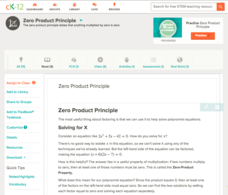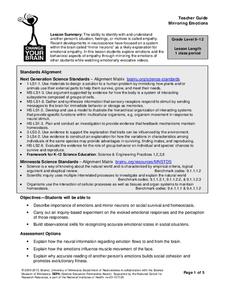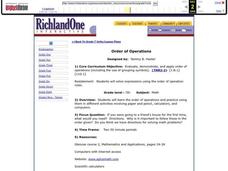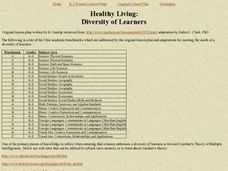Code.org
Using Simple Commands
Turtles might be slow, but class will zoom by when your pupils build a program in which reptiles draw a grid. Using App Lab and JavaScript, class members build a program to find the most efficient way to draw an image of a three-by-three...
Teach Engineering
Storing Android Accelerometer Data: App Design
There's an app for that! Pupils learn to build an app that will store data on an Android. The instructional activity introduces class members to the tiny database, TinyDB, for Android devices. A video tutorial provides an example that...
Microsoft
Final Independent Project
Finally ... the final project. As a culminating activity for the nine-part Intro to CS with MakeCode unit, scholars create a program within Minecraft that incorporates skills from the unit. They consider how to survive in the wild and...
Curated OER
House of the Spirits: Fun Trivia Quiz
This quiz about Isabel Allende's magic-realist novel, on the syllabus for many 10th graders, comes with well supported answers that could foster discussion, incite rereading, and enhance comprehension. If you have computer access in your...
CK-12 Foundation
Zero Product Principle
Some lessons feature videos, some interactive practice problems, and some have notes and activities. This comprehensive look at factoring and solving polynomial equations using the zero product principle has all of this and more. Though...
University of Minnesota
Mirroring Emotions
Do you ever give your class the "teacher look"? Without saying a word, they become silent and engaged (hopefully). How do they know what you're thinking? Explore the concept of nonverbal communication and how it relates to our mirror...
PBS
Stories of Painkiller Addiction: The Cycle of Addiction
Drug addiction, including prescription drug addiction, begins with a reason that's different for every user. High schoolers learn more about the reasons people begin abusing drugs with a set of videos and worksheets that discuss four...
Curated OER
Cause and Effect
Students examine the concept of cause and effect. They participate in a class discussion, play matching games, and play a memory/concentration game with cause and effect as the focus. Students complete an evaluation chart as an...
Curated OER
Electronic Components
Students review new terminology and computer circuits and the value of a resistor. They complete three experiments, "Resistance Activities," Transistor Activities,"Diode Activities" and enter data, results and their findings on Student...
Curated OER
The Scientific Method (Senior, Science)
Student's recall from memory the steps in the scientific method. TSWBAT describe in detail the various steps of the scientific method. TSWBAT analyze a problem or situation and apply the steps of the scientific method to it.
Curated OER
Feeding the Soul
Students share memories of a special meal. They research, write and peer edit a newspaper column about a favorite food associated with Thanksgiving (or other holiday or celebration).
Curated OER
Got the Picture?
Students explore the power of photographic images to influence public opinion. Then, using both news images and personal photographs, they create dual timelines documenting their own life experiences and memories.
Curated OER
Order of Operations
Seventh graders investigate the order of operations. In this seventh grade mathematics lesson, 7th graders explore the order of operations and practice using them in activities that involve paper and pencil, calculators and computers.
Curated OER
Making a personal brochure
Seventh graders prepare brochures that connect their date and year of birth with a famous person, a family memory and a significant world event, as well as the meaning or significance of their first name.
Curated OER
Healthy Living: Diversity of Learners
Learners are drawn to those activities that are in line with their individual intelligences. They use classroom computers to find fruits and their names in other languages. Once a fruit is identified, students practice saying the name of...
National First Ladies' Library
Rosie the Riveter
Learners identify and interpret the power of symbols. Then they research and identify what type of information that they can locate at the Library of Congress website and list what they learned from it in the time allotted. Students also...
Curated OER
Surface Area of Prisms
Students compute surface area and volume of prisms. In this surface area lesson, students find the surface area and volume of rectangular and triangular prisms. Independently, students use their computers to determine the volume,...
Curated OER
Pieces of Mind: Remembering What Matters
Pupils watch the program "Pieces of Mind" from PBS and participate in a class discussion about PET scans and their advantages. Students then brainstorm activities a PET scan could be used for.
Curated OER
Review of Pointers
For this programming worksheet, students answer 50 multiple choice and true or false questions on functions and binary numbers.
Curated OER
Aerospace Engineering
Students explore oil field applications of Shape Memory Alloys. For this engineering lesson students divide into groups and research mini research applications then complete a project.
Curated OER
Writing a Narrative
Sixth graders read the short story "Eleven". They write a narrative composition focusing on the use of voice. Students use a computer to create a pre-writing graphic organizer and type their final draft.
Curated OER
READ 180 Routine Assessment
Pupils complete assessments to determine strengths and weaknesses in their reading and writing skills. They use an educational software package to complete a computerized assessment. Afterward, they write a narrative about a memory in...
Curated OER
Technology in the Early Education Classroom
Learners explore computers. They type their names and use different fonts. They create mini-posters using Kid Pix software and use the Oregon Trail software to discover the westward trek in United States history. They explore websites...
Curated OER
Function Junction
Middle schoolers identify the internal and external components of computers, robots and fan. In this physics lesson, students draw a circuit diagram of their electronic components. They create a battery tester in the lab.

























